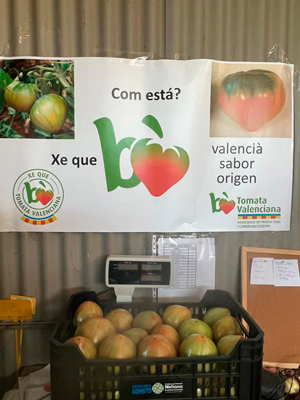The Tomata Valenciana obtains the CV quality mark
After almost four years of work coordinated by the COMAV Institute of the UPV, this distinction will help to protect and consolidate this variety of tomato, "one of the jewels of Valencian agriculture"
[ 27/03/2024 ]
From this month, the Tomata Valenciana has a new and great ally. After almost four years of work coordinated by the COMAV Institute of the Universitat Politècnica de Valencia, this variety, "one of the jewels of Valencian agriculture", has been awarded the "CV" quality mark by the Generalitat. This distinction will protect and consolidate this variety of tomatoes as a differentiated product.
The Tomata Valenciana is one of the most genuine products of Valencian agriculture. Its flavour, nutritional properties and morphological characteristics are unique worldwide, with a pointed shape and very tender and tasty flesh. It is mainly grown in L'Horta, Camp de Túria, Ribera Alta, Ribera Baixa, Alt Palancia and La Canal de Navarrés.
"This recognition allows to assign to the Tomata Valenciana a label synonymous with quality assurance and food safety in its production. The aim is to minimise the fluctuations in the price of this variety and contribute to ensuring the profitability of the Valencian farmers who produce it," says Salvador Soler, coordinator of the Group for the Conservation and Improvement of Traditional Valencian Varieties at the COMAV Institute of the UPV.
From 2020
The achievement of this quality mark is the fruit of work that began in 2020 with the creation of the "Associació de Productors i Comercialitzadors de la Tomata Valenciana", also promoted by COMAV-UPV. Since then, this association has worked on different fronts, such as the development of quality regulations to be able to obtain the CV brand, as well as in various research projects with a fundamental objective: to enhance the value of the product, ensure its conservation and contribute to its long-term future.
These projects have allowed, for example, the characterisation of the collection of varieties grown by the farmers' Association. This has led to the typification and establishment of the existing varietal subtypes: 'Blanca' and 'Masclet'.
MERESTOV Project
The MERESTOV project of the AGROALNEXT programme is currently being carried out under the coordination of Salvador Soler, aiming to improve the resistance and sustainability of the Tomata Valenciana. To this end, different actions are being developed, such as genetic improvement to make it more resistant to prevalent crop diseases or new strategies to improve its vigour and efficiency in water and nutrients. "The economic and social impact of the project will have a direct impact on the promotion of the Tomata Valenciana as a profitable Valencian agricultural product for Valencian farmers," concludes Salvador Soler.
Outstanding news
 The Diamond Army
The Diamond Army
Two students came up with the UPV initiative that has engaged more than 1,600 volunteers and shattered the false myth of the 'crystal generation'
 ARWU 2024
ARWU 2024
The Shanghai ranking reaffirms the UPV as the best polytechnic in Spain for yet another year
 Distinction of the Generalitat for Scientific Merit
Distinction of the Generalitat for Scientific Merit
Guanter has been distinguished in recognition of his research excellence in the development of satellite methods for environmental applications
 The new statutes come into force
The new statutes come into force
The Universitat Politècnica de València is the first university in Spain with statutes adapted to the new LOSU
 NanoNIR project against breast cancer
NanoNIR project against breast cancer
UPV Researcher Carla Arnau del Valle receives an EU Marie Curie grant to develop biosensors for the early detection of this cancer
 Large artificial intelligence language models, increasingly unreliable
Large artificial intelligence language models, increasingly unreliable
According to a study by the Universitat Politècnica de València, ValgrAI and the University of Cambridge, published in the journal Nature





